Calendar of events
A quick lesson on the history of steam heating.


|
Not current events. Those are easy to find. These are more difficult to find, but worth the trip. I hope they fill you with wonder and make you appreciate how far we’ve come in this fascinating industry.
On Feb. 4, 1850, a steam boiler in the lower Manhattan basement of A.B. Taylor Mfg. Co., exploded, killing 63 people. It was the worst such accident in American history. The entire building collapsed on its foundation. I. M. Singer lost the prototype for his sewing machine in the explosion. Such is the power of steam.
But people back then knew that already; they just hadn’t learned to be careful yet. Twenty years earlier on Feb. 24, 1830, the steamboat Helen McGregor was torn apart by a violent explosion while taking on passengers in New Orleans. Fifty people died and many more were injured. Nearly 60 riverboats had exploded before the Helen McGregor went up and each of those riverboats had a steam boiler.
On March 12, 1888, a record-shattering blizzard descended on New York City. As most people ran out of coal, customers of the New York Steam Co., the brand-new district-heating company, were the only ones to stay warm. District steam heating changed the face of American architecture because, with steam under the city streets, there no longer was a need for chimneys.
On March 31, 1891, Wallace C. Andrews was granted a United States patent for a “Method of Transportation” for pulverized coal. His intent was to transport coal dust in a pumped slurry from the mines of Pennsylvania east to New York City and west to Chicago. Once delivered, the coal would settle out of the slurry and then be burned by spraying it though high-pressure nozzles.
Two years later, Andrews exhibited his idea at the Colombian World Fair in Chicago and was granted an award by the Commission of Judges, who said, “This method is destined ere long to become the carbon thoroughfare for the transportation of the motive power of the ages.” Both Andrews and his idea died prematurely. We did wind up with a lot of oil pipelines, though. And now you know where the idea came from.
Steam boilers
On April 15, 1824, Philadelphia's Franklin Institute announced, with great concern, the formation of special committees to closely examine “new inventions.” They did this because many of the “new inventions” were steam boilers and we both know how that worked out.
On May 9, 1864, James Roosevelt of Poughkeepsie, N.Y., had two steam boilers installed in his home at a cost of $1,500 plus the old furnace. His son, Franklin Delano Roosevelt, was born 18 years later and was reared in a very comfortable home.
On April 8, 1872, Yale University President Noah Porter wrote about the university’s experiment with steam heating, saying, “We are so pleased with it, as to contemplate using it more extensively in the future.” They did.
On May 3, 1882, the New York Steam Co. sent steam a half-mile under a lower Manhattan street to its first customer, the United Bank Building at 88 Broadway. Nothing exploded, which was a surprise to many. Imagine living in times like those.
Steaming ahead
On June 1, 1889, the G.M. Davis Regulator Co. of Chicago patented the Victor No. 2, an automatic air vent for steam radiators. It worked by the expansion of a composition element. It would be years before the industry produced a truly reliable air vent that didn’t squirt water all over the curtains, but this was a nice start. Nowadays, we take air vents for granted, but they did not arrive easily.
On June 18, 1898, C.E. Van Auken of the Clarence E. Van Auken Co., in Boston, introduced a steam-heating system that would operate under both pressure and vacuum through a new type of regulator, thus eliminating the need for radiator supply valves. Today, many contractors stare at the remnants of Van Auken’s systems and try to figure out what the heck that guy was thinking.
On Aug. 1, 1904, the Nason Mfg. Co. introduced its high-pressure steam radiator. Nason built it from 1-in. steel pipe and intended for it to be used on steamships, war vessels, tug boats and yachts. According to Nason, these radiators were safer than the cast iron aboard a marine vessel, which was a comforting thought.
On Aug. 14, 1903, John Collis of Des Moines, Iowa, filed a patent for a one-pipe steam supply valve that could be throttled. I don’t think that worked out very well. Ever hear of the guy or see his leftovers?
On Aug. 24, 1899, James J. Dick of Beaver Dam, Wis., wrote to Ciblin & Co., a boiler manufacturer in Utica, N.Y. He reported he was able to heat his 13-room house, which was exposed on all sides and contained 1,300 ft. of radiation, with its No. 70 Standard Sectional Boiler. He also reported the winter had been one of the longest and coldest in memory. Ciblin & Co. ran ads explaining physicians recommended their boiler. Ever try asking your doctor a question about a boiler?
On Sept. 8, 1897, Thomas K. Peters, a representative of the Western Paul Steam System Co. of Saint Louis, Mo., began work on a Paul steam system in the new Ely & Walker building, which was a dry-goods warehouse. Look around most old cities and you’ll see remnants of the Paul System. It’s those tiny pipes that poke from the floor around those wonderful old radiators. The Ely & Walker building is now filled with luxury residential lofts.
On Oct. 3, 1854, Steven Gold patented his “mattress” radiator. It was the first safe steam radiator for house heating. I can tell you where to go if you’d like to see some of these today. What are you selling now that will still be working in 2174?
On Nov. 5, 1880, the Denver City Steam Heating Co. began supplying steam heat and power to the frontier city of Denver. Denver’s district steam system is older than New York’s, and similar to New York’s, is still very much alive. They got the idea from Birdsill Holly of Lockport, N.Y., who not only invented district heating but also the fire hydrant. He tried to sell the latter to the good people of Chicago before they had their big fire, but they didn’t think they’d ever need them. Oh, well.
On Dec. 1, 1899, Professor Rolla C. Carpenter of Cornell University addressed the Carbon Club in New York City. Among other profound comments, he noted, “It is of little use to install a boiler that will absorb more heat than the radiators will give off.” Even then, Professor Carpenter knew it made no sense to oversize boilers. It still doesn’t.
On Dec. 15, 1921, Chicago’s commissioner of health called fresh attention to the requirements for furnishing the proper amount of heat in apartments. He offered the following suggestion, “Both owners and tenants should try to apply in a sane and practical way the Golden Rule of doing unto others as you would have others do unto you.”
They’re still trying to work on that one.
HELPFUL LINKS:
Looking for a reprint of this article?
From high-res PDFs to custom plaques, order your copy today!






